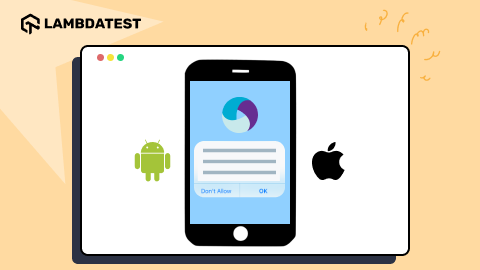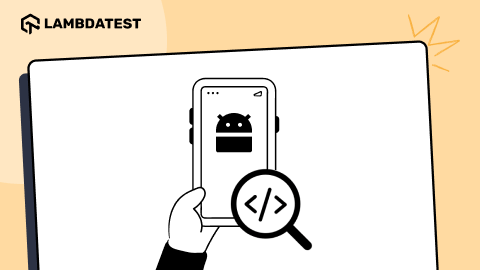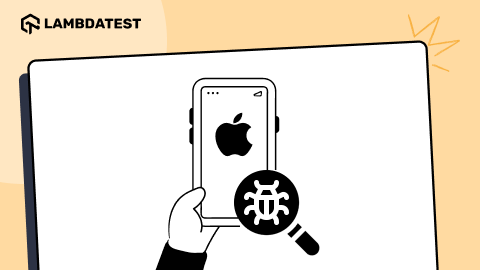Top 24 iOS Testing Tools for 2024: Choosing the Best Framework for iOS
Nazneen Ahmad
Posted On: February 26, 2024
![]() 191924 Views
191924 Views
![]() 35 Min Read
35 Min Read
It’s 2024, and we all depend on the mobile app for everything ranging from social media to fitness and daily work. According to Statista, approx. 257 million downloads of mobile applications were noted in 2023. In 2025, mobile apps are projected to generate revenue of above 613 billion U.S. dollars.
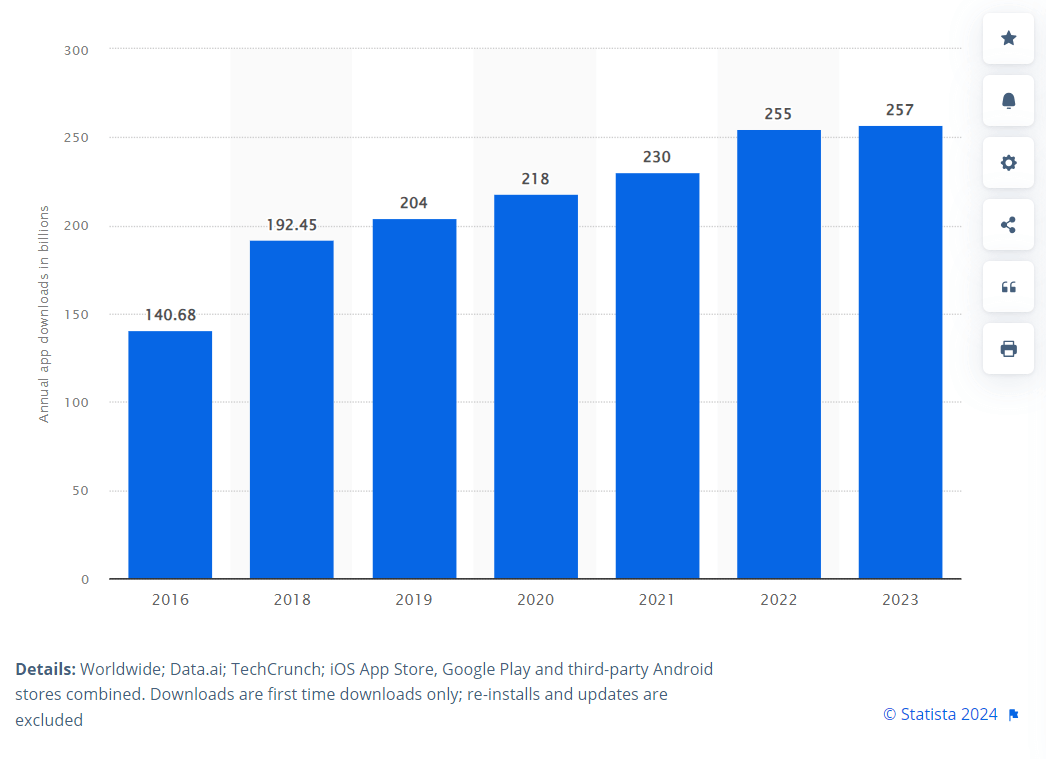
The data indicate that with time, there is expected to be a continuous surge in the competition to release high-quality mobile apps. The best approach to stay in the competition is to develop a highly-quality and functional mobile application. However, having bugs in the mobile app can ruin the developers’ efforts. Hence, this requires you to test mobile apps to ensure they perform optimally and meet user expectations.
However, mobile apps are differentiated based on the OS, like Android and iOS. Although Android has dominated the market with a total market share of 69.94% compared with 29.32% of iOS, it is important to note that by the fourth quarter of 2022, the mobile app generated 8.1 billion downloads in the Apple App Store.
Thus, a survey shows that the Google Play Store has made up the bulk of app downloads, but the Apple App Store was stronger in revenue generation. The number of users of iOS applications (apps) is increasing; thus, ensuring the quality and functionality of mobile apps has become more critical than ever. This necessitates testing the iOS apps to ensure they perform optimally and meet user expectations.

To detect and fix bugs early, bring up the importance of mobile test automation and iOS testing tools in the development and testing process. This helps to ensure that iOS apps function seamlessly across various devices and platforms. As the number of iOS apps grows, developers and QAs must leverage the best iOS testing tools to ensure their apps stand out in the crowded market. With so many iOS testing tools available, choosing the best one for your specific testing requirements can be challenging.
This blog contains a list of the top 24 iOS testing tools for 2024 that developers can leverage to ensure the quality and functionality of their iOS applications.
With this, you will gain valuable insight into the diverse options available and allow you to choose the right iOS testing tool that aligns with your specific testing requirement.
TABLE OF CONTENTS
Overview of iOS App Testing
In simple terms, you can understand iOS app testing as a process where iOS apps are validated for their functionality on Apple devices like iPhones, iPad, or ioS Simulators and check whether it works as per end-user expectations. This also checks specific user actions like installation time, user interface, behavior functionality, load time, user experience, OS version support, and others.
iOS is the operating system designed by Apple, released on June 29, 2007. Apple does not license iOS for its installation on non-Apple hardware. The iOS and its application can only be installed on Apple devices, and it is crucial to consider that it is compatible with all its iOS versions and devices. This makes iOS app testing significant and critical.
No matter how much time developers invest in developing iOS apps, some bugs in the iOS app can create enormous challenges for organizations. Some of those are application crashes during execution, iOS app incompatibility with the iOS version, security vulnerabilities, and memory leaks. Such challenges need to be overcome by executing iOS app testing.
iOS app testing helps to identify bugs, and glitches that may interfere with an app’s performance, ensure the quality standard of apps, improve user experience, and ensure that the app aligns with guidelines and standards of app development. Thus, you should always perform iOS app testing with criticality when you are involved in developing iOS apps.
What are iOS Testing Tools?
iOS testing tools are software programs, frameworks, or libraries designed to test the functionality and performance of iOS apps. They allow developers and testers to write test scripts, measure app performance and mimic user interaction. In other words, these tools automate the testing of iOS apps, making it easier and faster for the tester to identify and fix bugs.
You should know that iOS testing tools utilize unit, integration, acceptance, and functional testing techniques. Such tests allow us to verify the behavior of the iOS app and ensure that it is in line with the expectation of the end users. Now, let us dig into top iOS testing tools.
Why need iOS Testing Tools?
iOS app testing can be performed either through a manual or automated approach. In manual testing, human testers test the app by exploring its features, functionality, and user actions to identify any issues. However, manual testing is mainly prone to error and can be time-consuming. Still, we cannot ignore manual testing as it helps you to identify bugs in iOS apps that might be missed by automated testing.
For reliable iOS app testing, automation testing of the iOS app is undoubtedly the best way out. In automated testing, iOS testing tools are leveraged to execute test scripts that mimic user interactions and scenarios. It will help to automate the test of repetitive tasks. Hence, in this blog, We have mainly focused on the best iOS testing tools which offer features and functionalities like UI testing, performance testing, and compatibility testing.
Test your iOS applications on real devices. Try LambdaTest Now!
Top 24 iOS Testing Tools for Mobile Automation
Here, we will explain the best iOS testing tools for 2024.
LambdaTest
LambdaTest, an AI-powered test orchestration and execution platform, is one of the best-streamlined solutions for iOS app testing. With LambdaTest, QA engineers can test iOS apps on real device cloud manually or automatically through its iOS automation testing cloud using framework for iOS like Appium and XCUITest.
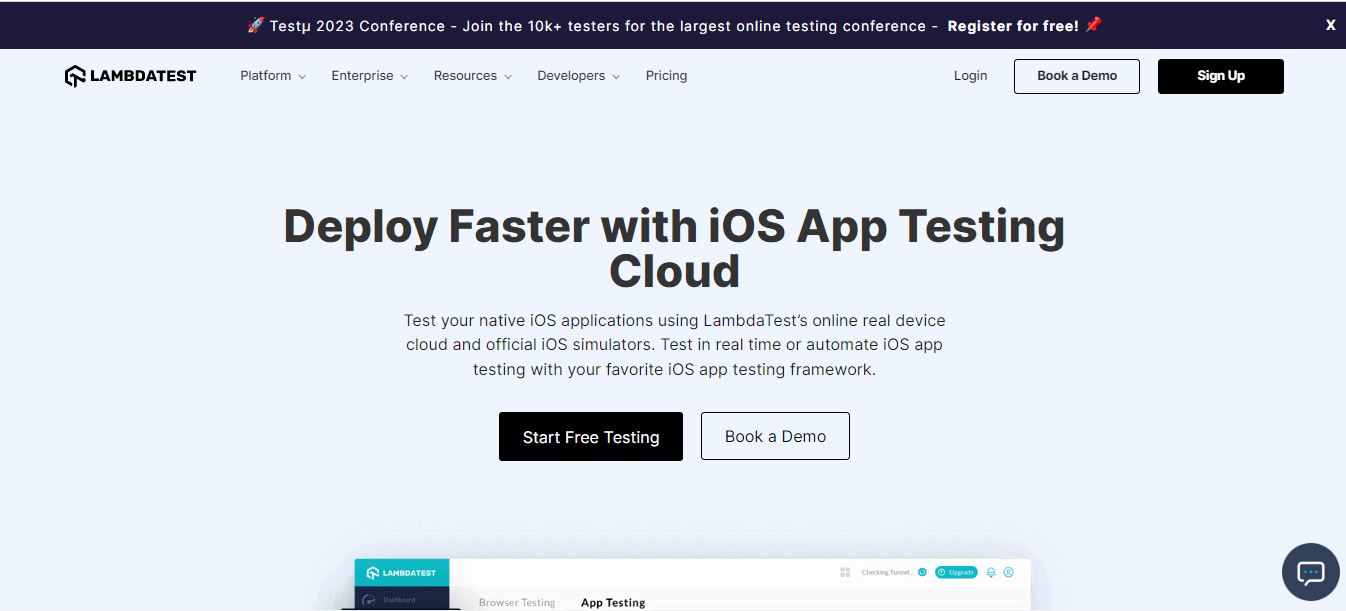
LambdaTest’s iOS app testing platform eliminates the need to maintain an in-house device library or create simulators. Such tasks are time-consuming and expensive. To waive these challenges, LambdaTest offers you just to choose your desired iPhone and iPad devices or iOS Simulators and get started with the testing process.
Key features:
- You can directly upload your .apk, .app, or .zip files to the platforms and initiate testing with just one click upload.
- You can effortlessly test your privately and locally hosted apps for compatibility before releasing them to the live environment.
- You can identify and debug the native app in real time using screenshots, videos, network logs, and device logs.
- You can assign bugs directly from the LambdaTest platform to the developers for quick fixes.
- LambdaTest is compatible with framework for iOS testing like, Appium and XCUITest to automate iOS app testing.
- Offers one-click bug logging, detailed test logs, and insights that help you to deliver quality builds faster.
Visit our support documentation to get started with app automation on LambdaTest.
Subscribe to our LambdaTest YouTube Channel for the latest updates on tutorials around Selenium testing, Cypress testing, and more.
Appium
Appium is one of the most popular iOS testing tools, which works well for native, hybrid, and web app testing on real devices and iOS Simulators. It uses JSONWire protocol to communicate with iOS applications utilizing Selenium WebDriver. The best part of Appium is that it can use language-specific client libraries that make it possible to code in different languages like Java, Python, JavaScript, PHP, and others.
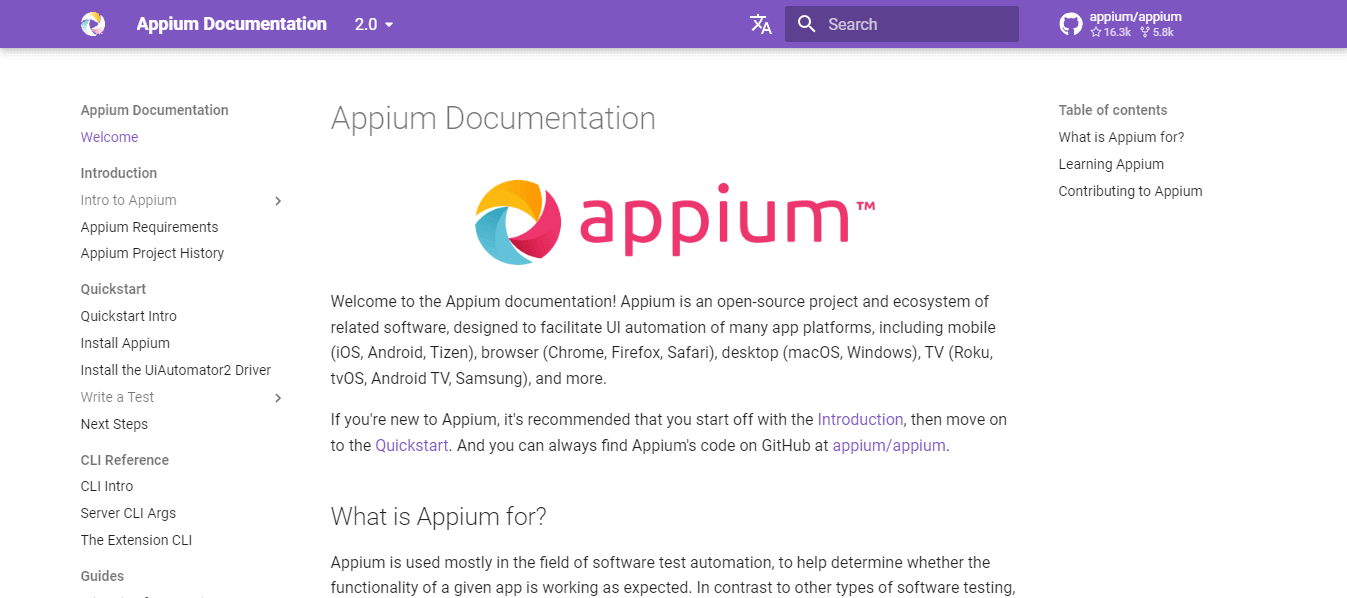
Key features:
- It is an open-source iOS testing tool that can be freely accessible by all testers and developers.
- Provide access to the backend APIs and database from test code, increasing the flexibility in iOS app testing.
- It has an easy set-up process, so you can quickly start the iOS testing process.
- You can also reuse the source code within the iOS ecosystem.
- It is a cross-platform tool for platforms like Windows, macOS, and Linux.
- Appium has a graphical user interface (GUI) wrapper, which you can download for any platform.
- Appium supports various automation testing frameworks like Cucumber and TestNG.
- You can test iOS apps without recompiling their code or modifying the codebase and framework.
XCUITest
XCUITest is an integral automation framework for iOS developed by Apple. XCUITest is the extension of the XCTest that validates the functionality of the specific code units in an iOS app. Using XCTest, you can write UI tests to verify the behavior of the UI of iOS app elements like buttons, text fields, and menus.
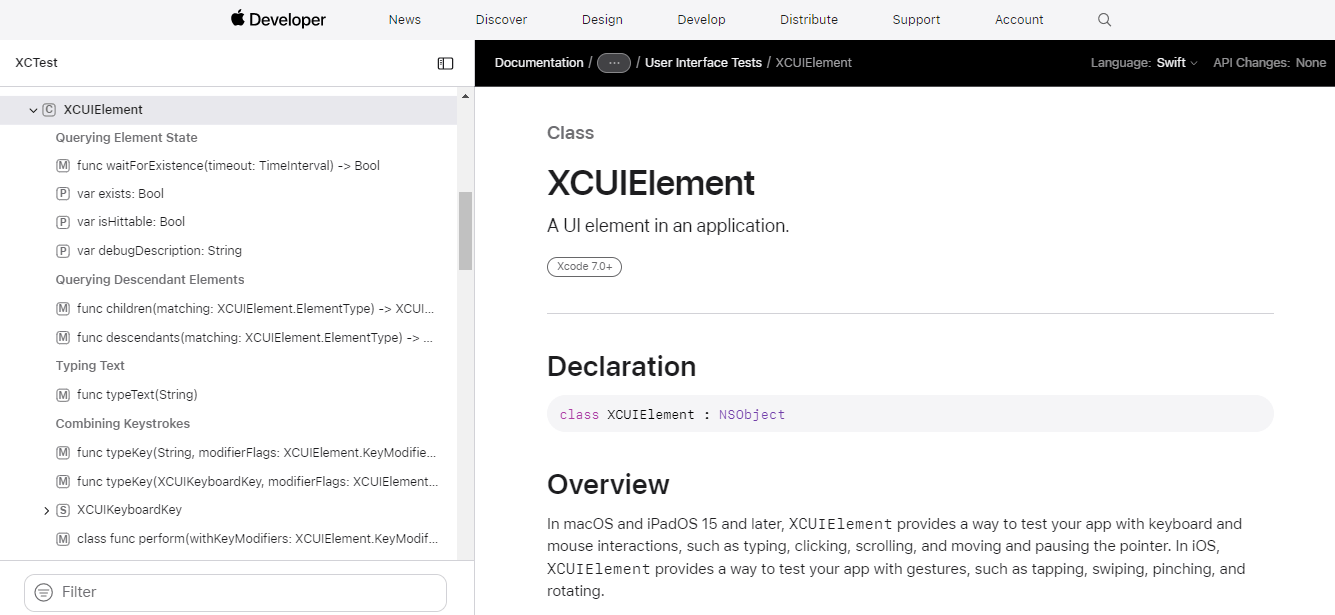
Key features:
- Offers additional classes for optimum UI testing like UIAccessibility.
- You can write test cases in Swift or Objective-C, mainly packed in an IPA runner. This is the key programming language used for iOS app development.
- It integrates seamlessly with Xcode, frameworks for iOS, and third-party tools. It also integrates with Apple’s IDE for iOS app development.
- Offer Xcode integration which facilitates the writing of test scripts. You can use subclasses or assertions to write the test and debug test cases.
- Supports integration with Continuous Integration/Continuous Delivery (CI/CD) pipelines. With this, you can automate the iOS app testing workflow and ensure its functionality before its release in the Apple App Store.
- It supports black box testing, and you can test the functionality of the iOS application even if you don’t know its internal structure and implementation.
Apptim
Apptim is one of the top iOS testing tools that allow you to verify the functionality and performance on real devices. Using Apptim, you can get the accurate behavior of the iOS app in the real world. Further, you can use Apptim efficiently because there is no need to make any significant changes to the code of the iOS or get any heavy software development kit installed that may impact the performance.
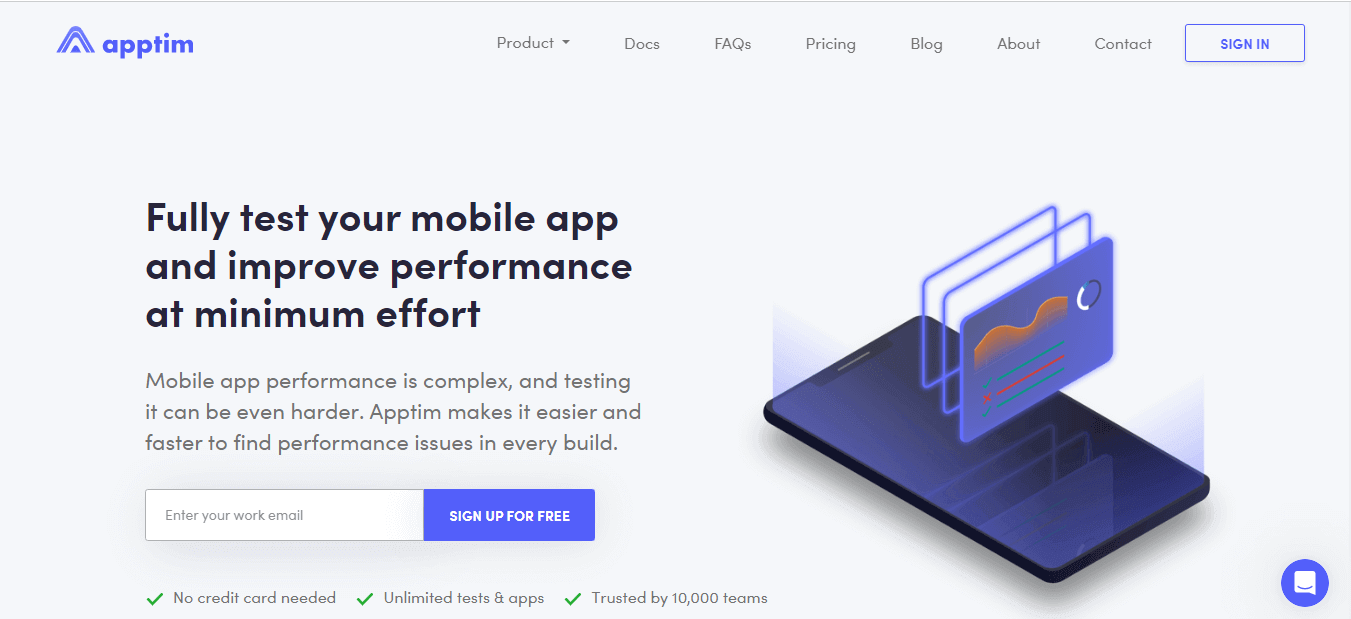
Key features:
- It provides detailed reports on diverse aspects of the performance of the iOS app. This may include information on the render time, power consumption, crashes, errors, and resource usage.
- The report on the iOS app testing can be shared with the developers in the private workspace, which makes collaboration easy and helps identify an area of improvement.
- It is easy to set up and does not require installing any other software development kit.
- It integrates with Jira, and you can easily publish and track bugs. You can streamline the development process and manage app development’s testing and bug-fixing phases.
- It gives various automated testing options like UI, API, and end-to-end testing.
- Provide detailed analytics on how users can interact with the iOS apps that allow developers to optimize the user experience of iOS apps.
Katalon
Katalon is a test automation platform that provides a comprehensive set of functionalities that supports iOS app testing. Katalon Studio uses the Appium framework for iOS app testing, which supports a different range of iOS devices and versions. With its user-friendly interface for test case creation, execution, and reporting, its use is easy.
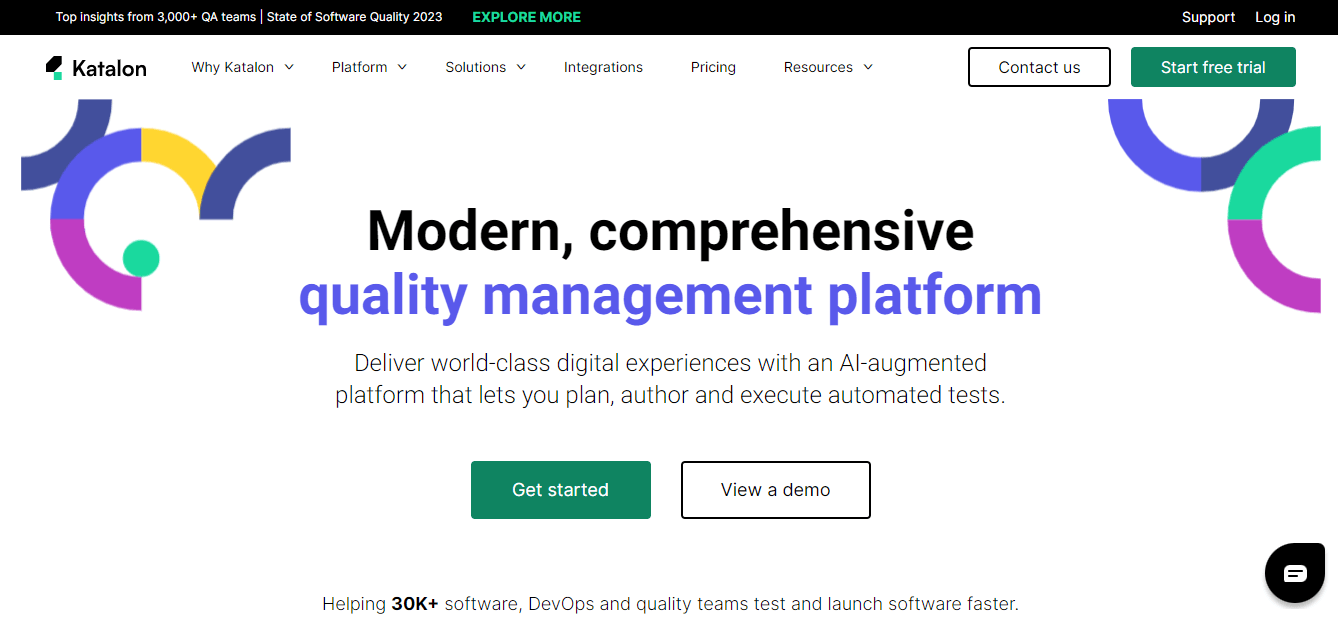
Key features:
- Supports integrating third-party tools and frameworks like Jira, Jenkins, and Git.
- It offers manual and script modes to toggle between low-code and scripting options.
- It supports image-based testing, and you can capture and locate visual elements.
- It easily integrates with CI/CD systems like Bamboo, Travis CI, Azure DevOps, and CircleCI.
- You can easily record and replay the test, through which it is easy to create automated iOS app tests without any requirement to write code manually.
- Offer Object Spy feature that helps testers verify the UI elements of iOS apps and create test cases that interact with them.
- Supports test execution on real iOS devices, which helps you to check whether iOS apps are compatible with various devices and versions.
- Provide customizable reporting options; with this, you can generate reports tailored to your needs.
Squish
Squish is a a GUI testing tool for automating tests on iOS apps. It offers capabilities for automated GUI testing on iOS devices and the simulator.
It supports the creation and execution of multi-application tests, allowing testers to validate interactions between different apps. Additionally, the tool facilitates multi-device testing, enabling comprehensive testing scenarios across various iOS devices.
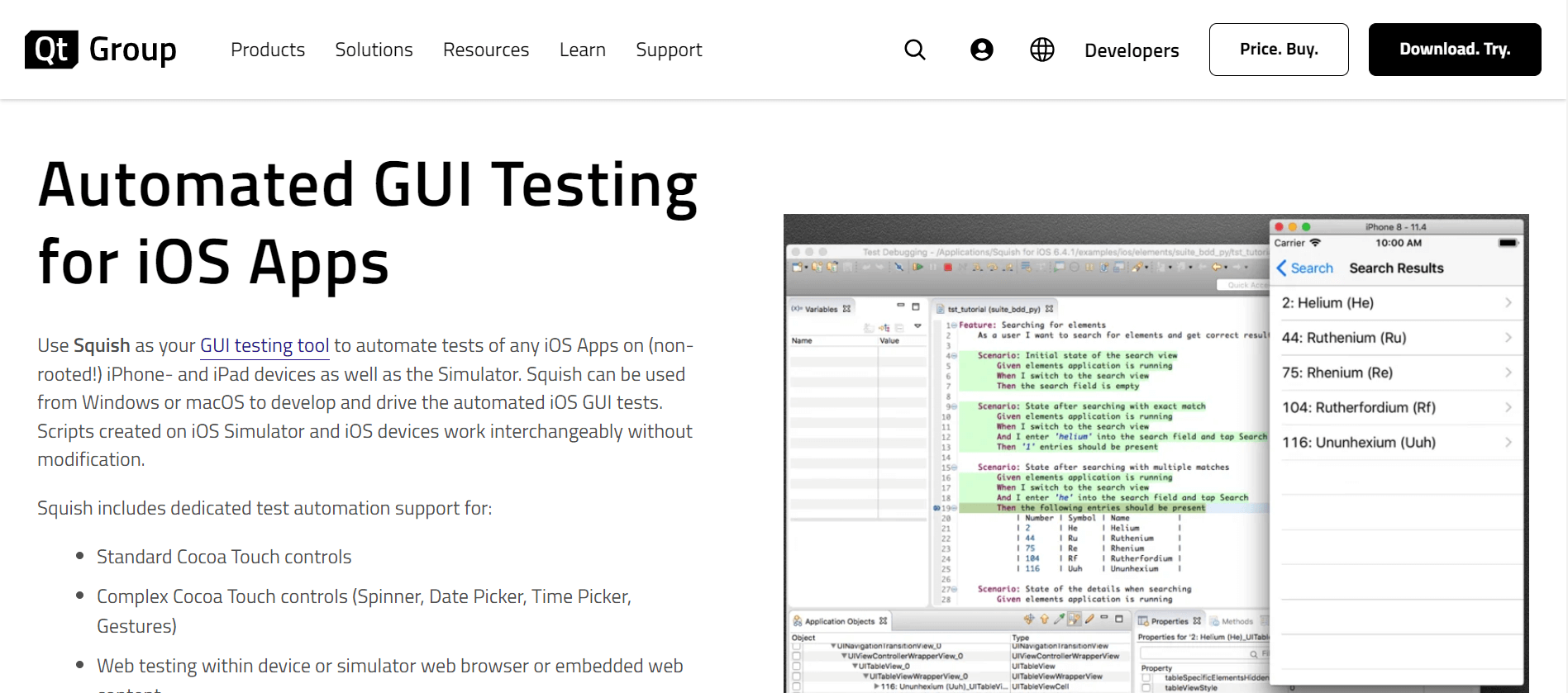
Key features:
- Supports non-rooted iPhones and iPads, as well as the iOS simulator. This allows for the automation of tests on both physical devices and simulated environments.
- Scripts created for iOS Simulator and iOS devices can work interchangeably without modification. This feature enhances the reusability of test scripts across different testing environments.
- Squish allows you to develop and execute automated iOS GUI tests from both Windows and macOS environments. This flexibility can be beneficial for teams with diverse development setups.
- Scripts created for iOS simulator and iOS devices can work interchangeably without modification. This feature enhances the reusability of test scripts across different testing environments.
- Squish provides dedicated test automation support for a range of iOS elements, including standard Cocoa Touch controls and more complex ones like Spinner, Date Picker, Time Picker, and Gestures.
fastlane
fastlane is an open-source platform and set of tools that facilitates the automation of the iOS app development and deployment process. Developed by Felix Krause, fastlane simplifies common tasks associated with mobile app development, deployment, and distribution.
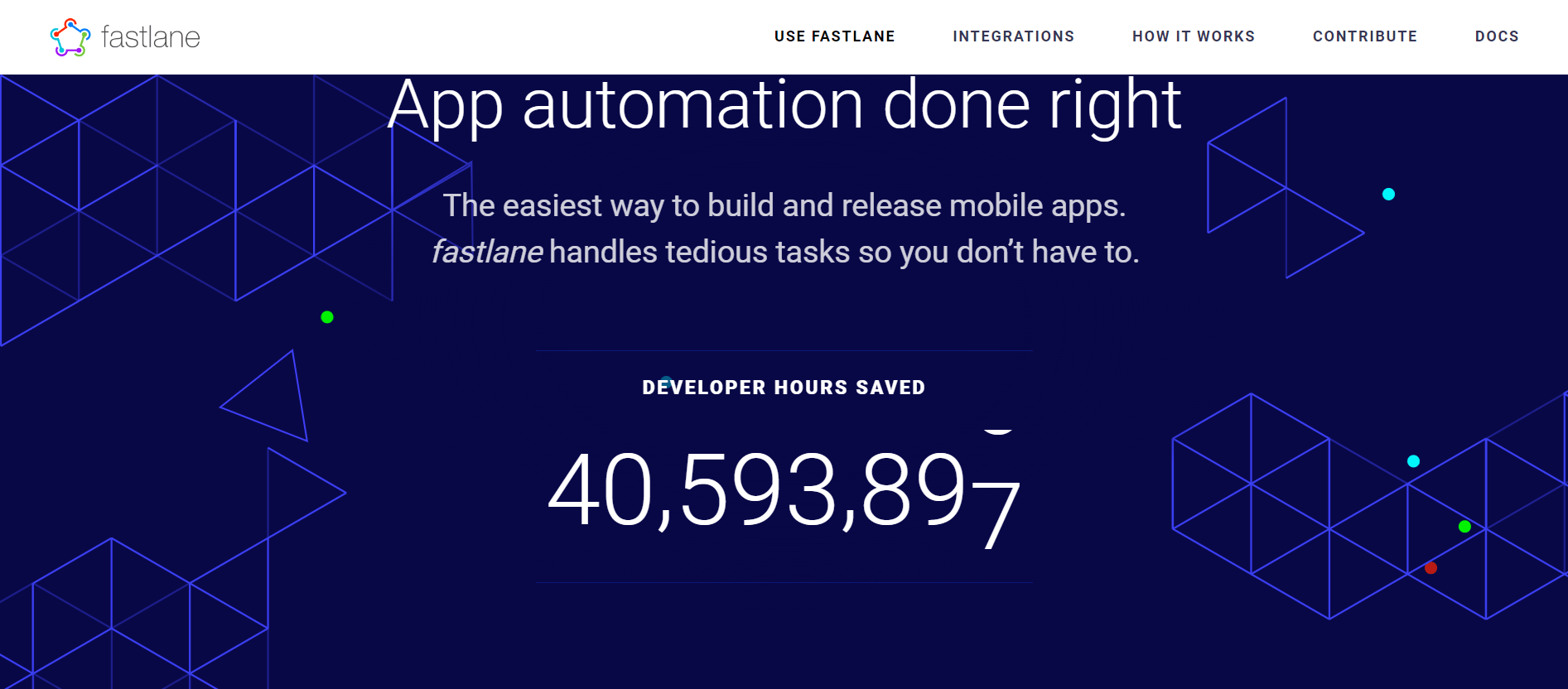
Key features:
- It streamlines and automates various aspects of the mobile app development lifecycle, making it an essential tool for Mobile DevOps.
- While initially focused on iOS, fastlane now supports both iOS and Android app development, providing a unified solution for automation across platforms.
- Easily integrates with popular CI tools like Jenkins, Travis CI, and others, allowing for seamless automation within the CI/CD pipeline.
- Handles the building of mobile app projects and automates the code signing process, reducing manual errors and simplifying the release workflow.
Frank
Frank is an open-source automation testing framework for iOS that only supports iOS app testing. Frank allows you to write tests in natural language syntax, making creating and maintaining tests easy.
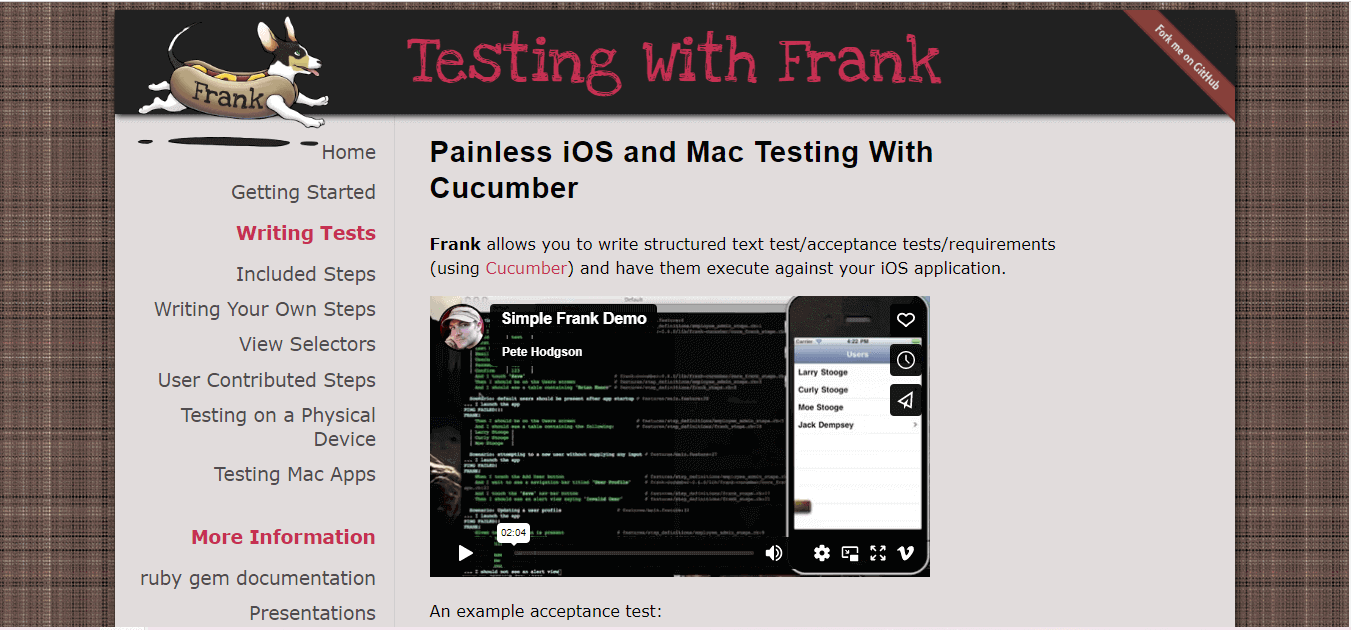
Key features:
- It interacts with the user interface of an iOS app and underlying code, which makes it a powerful tool for iOS app testing.
- You can perform iOS app testing across multiple devices and simulators simultaneously.
- It utilizes a combination of Ruby and Cucumber testing frameworks to write and run iOS tests.
- Generating HTML reports of test results is possible with Frank which gives a detailed overview of the tests and any encountered bugs or errors.
- Its integration of JSON with Cucumber allows you to have a comprehensive and detailed iOS app test.
Ranorex
Ranorex is an iOS testing tool that offers end-to-end testing for iOS apps. It is explicitly designed for executing and creating tests on iOS devices and simulators. It provides capabilities that enable developers to maintain robust and reliable tests which ensure iOS apps are thoroughly tested.
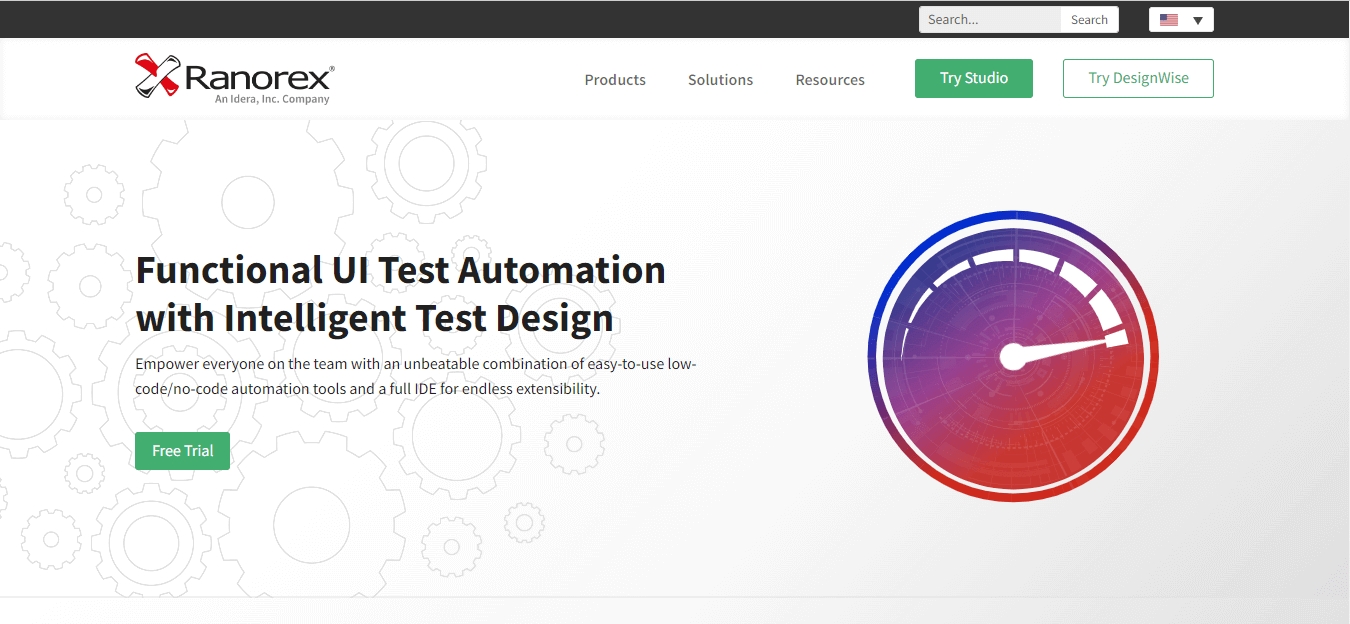
Key features:
- Ranorex for iOS app testing is very easy due to its intuitive graphical user interface, which helps you to create and run tests quickly.
- There is no need to write complex code for iOS app testing hence can be used by unskilled testers.
- You can test the iOS app on different iOS devices and simulators across different screen sizes and resolutions.
- It offers a device cloud for remote testing that integrates with Continuous Integration (CI) tools like Jenkins. You can automate tests of iOS apps as part of the CI/CD pipeline.
- You can automatically identify and track UI elements in iOS apps and easily create tests that interact with particular buttons, fields, and UI components.
- It has an image-based recognition feature that allows the creation of tests that interact with non-standard UI elements.
EarlGrey
EarlGrey is an open-source iOS automation testing tool developed by Google to perform UI test automation in iOS. EarlGrey is used by Google internally to conduct functional testing of native iOS apps like Google Calendar, YouTube, Google Photos, Google Translate, and others. It provides QAs with different assertions to verify the UI elements and properties like text, visibility, and position.
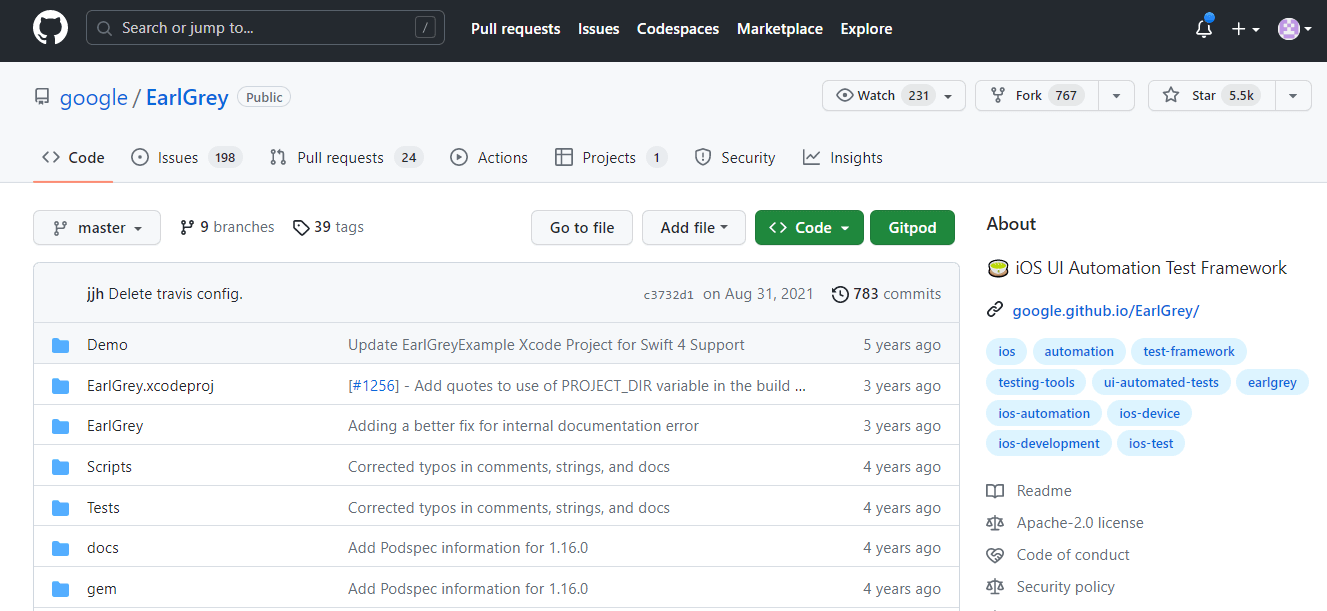
Key features:
- It provides an easy-to-read and understandable syntax for UI interaction, allowing you to write and maintain test scripts.
- Its built-in synchronization is a key feature designed to ensure that test scripts easily interact with the user interface of iOS apps when it is stable.
- EarlGrey automatically synchronizes with the UI, network requests, and various queues like Dispatch Queue and NSOperationQueue.
- EarlGrey allows you to wait for a specific UI event to take place before starting an interaction with the UI of the iOS app.
- Supports accessibility testing, and you can ensure that people with disabilities use iOS apps.
- It has accessibility-specific assertions and APIs for interaction with VoiceOver and other accessibility features.
- Supports parallel testing through which you can simultaneously run tests on multiple devices and simulators. This reduces overall testing time.
- It integrates with Xcode, so you can run your test directly within IDE and get results in the Xcode console.
Firebase Test Lab
Firebase Test Lab is a cloud-based iOS testing tool that allows testing iOS apps on various devices and configurations hosted on Google’s cloud infrastructure. Fire Test Lab is designed by Google, which supports real device testing, automated testing, and customizable test scenarios.
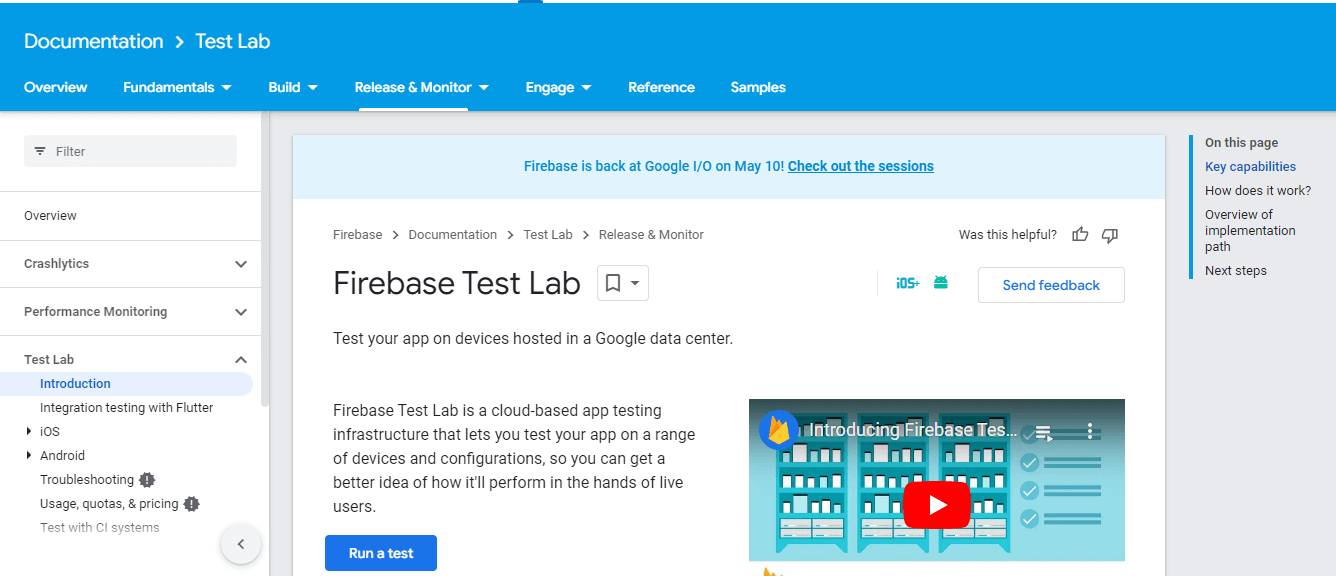
Key features:
- You can test your iOS apps on a wide range of devices and OS versions which helps ensure that it is compatible with various Apple devices.
- With Firebase Test Lab, you can test your iOS apps on real devices, which gives more realistic testing environments.
- It supports automated testing for iOS apps; you can run tests simultaneously on multiple devices.
- You can customize the test scenario by mentioning its test parameters like device orientation, language settings, and network conditions.
- It integrates with Xcode, and testing of iOS apps from within the IDE is possible.
- You can get detailed test reports of the testing process, including screenshots and videos, which allows developers to identify and fix issues quickly.
MonkeyTalk
MonkeyTalk is an open-source automated iOS testing tool developed by Gorilla Logic. When you use MonkeyTalk, it is possible to create and execute automated functional, performance, and acceptance tests for iOS apps. It is the perfect iOS testing tool for beginners due to its easy-to-understand scripts.
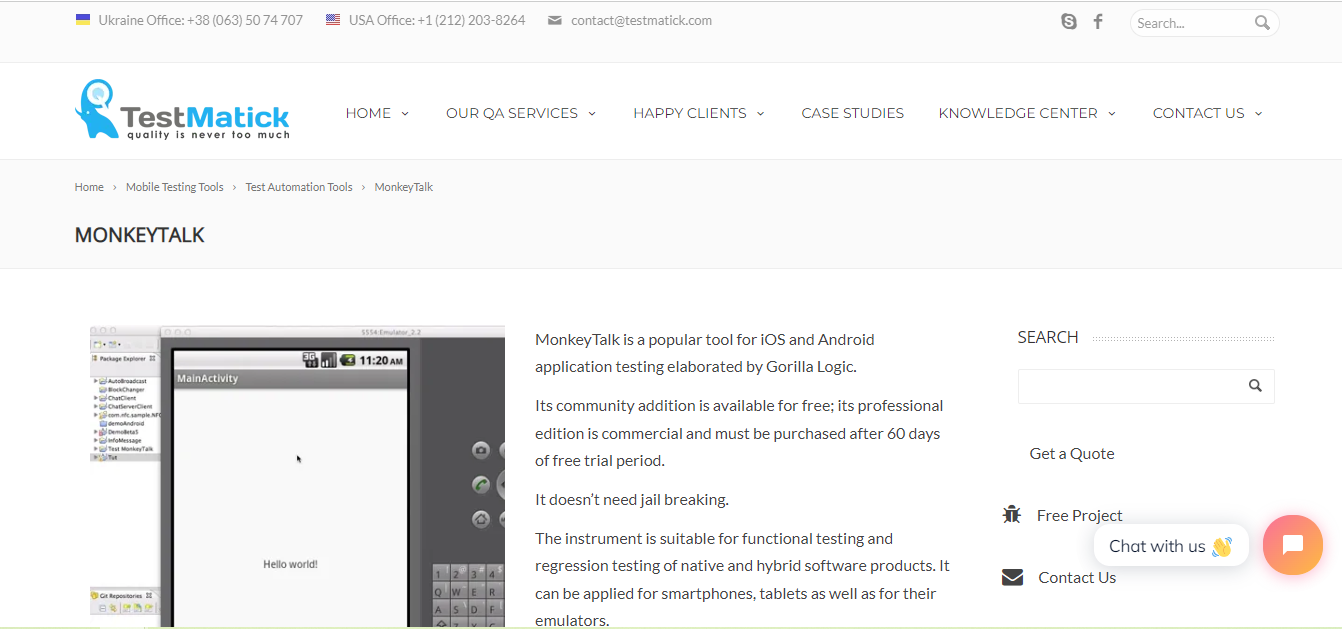
Key features:
- You can record user actions and events while performing iOS app testing and playback such actions as part of your automated test scripts.
- You can identify UI elements with its Object Spy feature in your iOS app.
- With MonkeyTalk, you can write test scripts in plain English based on its feature of keyword-driven scripting language.
- Supports iOS app testing on diverse platforms, including Linux and Mac.
- You can perform data-driven testing of iOS apps using data sources like databases and spreadsheets.
- It integrates with IDEs like Xcode and Eclipse and continuous integration tools like Bamboo and Jenkins.
Quick
Quick is an iOS testing tool designed for Swift and Objective-C, drawing inspiration from RSpec, Specta, and Ginko. It is built on top of XCTest, which is Apple’s framework for implementing unit testing functions. While XCTest is functional, some users may find it verbose and repetitive after working with it for a few days.
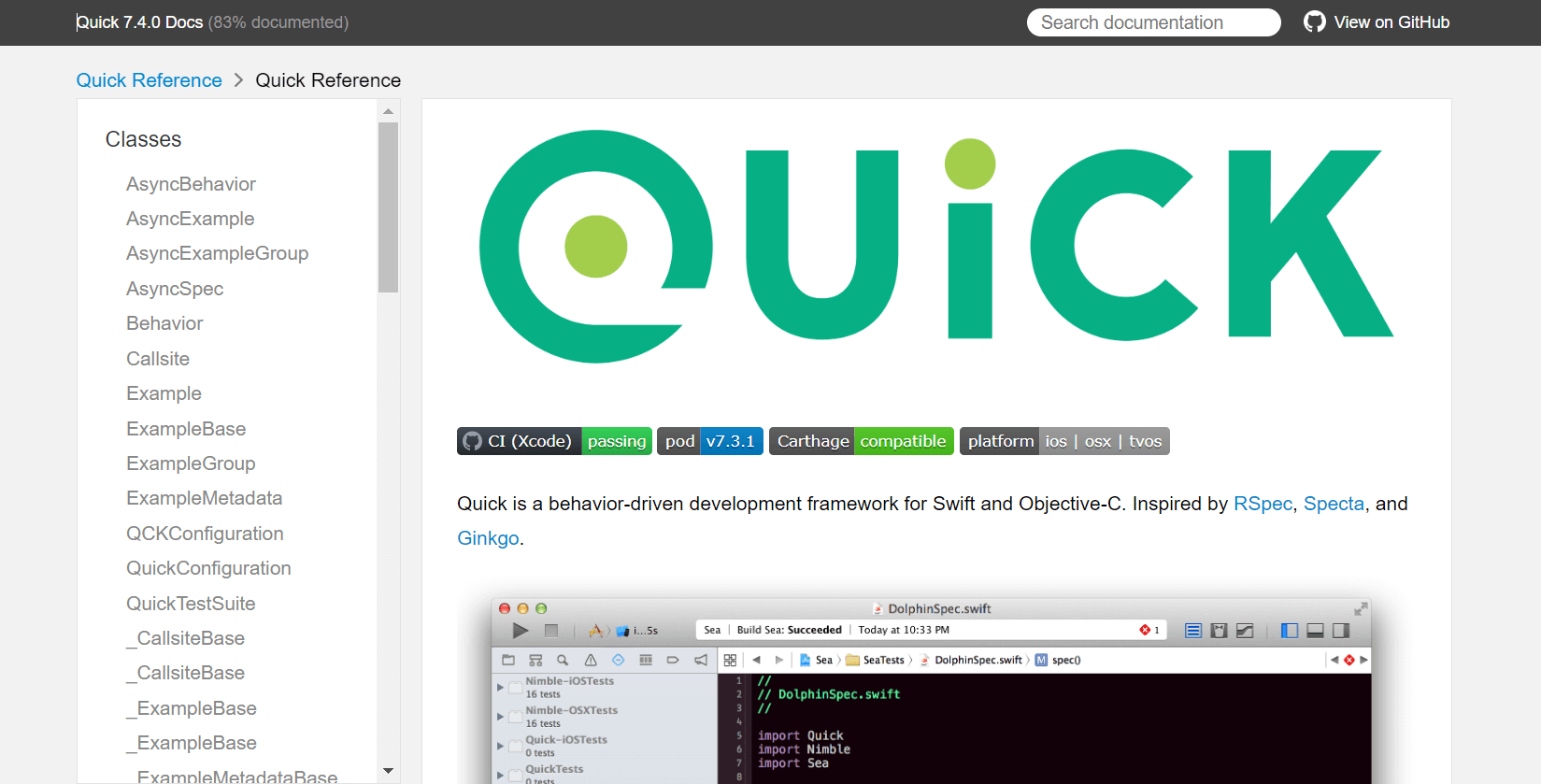
Key features:
- Quick is specifically designed for BDD, making it easy to write tests in a natural language style, enhancing readability.
- Utilizes XCTest, Apple’s native framework for unit testing, as its foundation, ensuring compatibility with Xcode and Swift.
- Supports organizing tests into different contexts, providing a clearer structure for test suites.
- Unlike XCTest, Quick does not mandate the “test” function prefix, providing flexibility in test function naming.
- Offers a user-friendly experience, streamlining the test-writing process and reducing the learning curve for new users.
Xamarin.UITest
Xamarin.UITest is a C# testing framework that uses NUnit for acceptance testing on iOS apps. In other words, Xamarin.UITest is the automation library to perform NUnit tests on iOS devices.
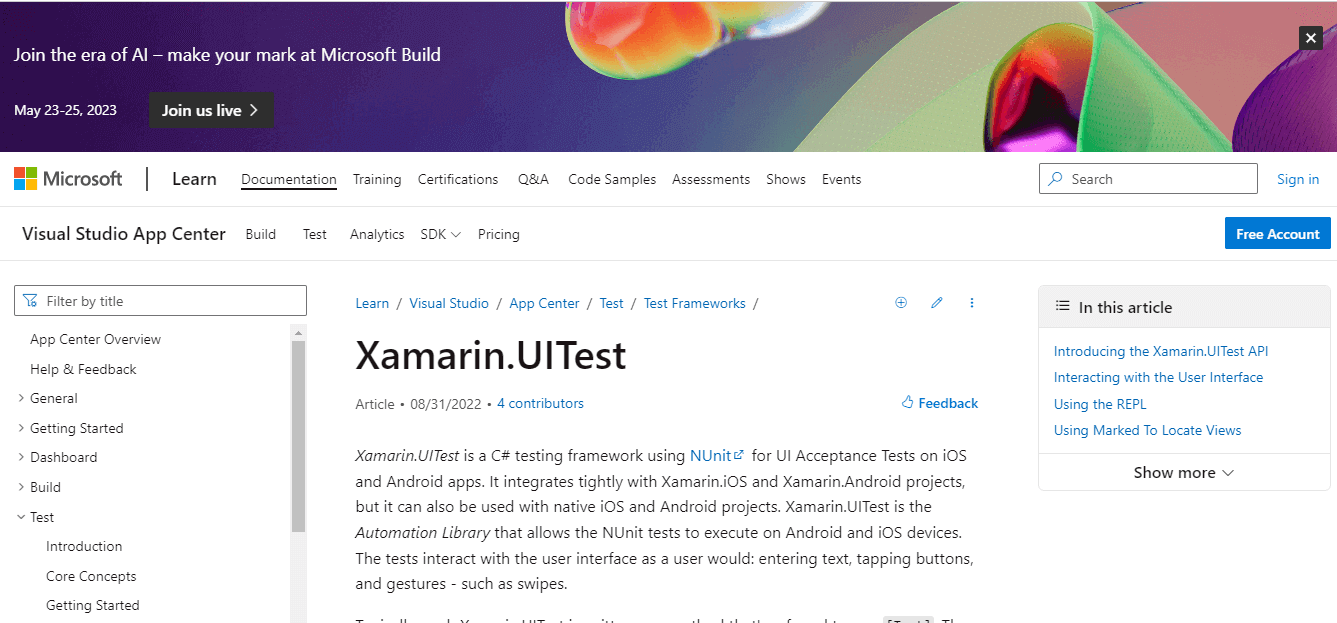
Key features:
- It is an iOS testing tool that helps developers to create and run UI acceptance tests for iOS apps on Apple devices.
- Particularly, it allows you to test in both Xamarin apps and native apps, which are developed using standard iOS tools.
- If you use Xamarin.Forms to develop your iOS app, Xamarin.UITest helps you with a similar option to create and run UI acceptance tests for iOS apps built.
- It integrates with Xcode; with this, you can run tests directly from Xcode and monitor test results within its interface.
- Allows you to run and test iOS apps on physical iOS devices and simulators, which gives them the flexibility to your testing approach.
KeepItFunctional (KIF)
KeepItFunctional (KIF) is an integration testing framework for iOS that allows you to easily automate iOS apps by leveraging its accessibility ability. This makes the OS available for users with visual disabilities.
Utilizing the standard XCTest testing target, KIF can build and perform iOS app testing synchronously in the main thread as the app’s UI, which gives more logic and composition. As it uses XCTest as a testing framework, KIF uses Xcode Test Navigator, command line build tools, and Bot test reports.
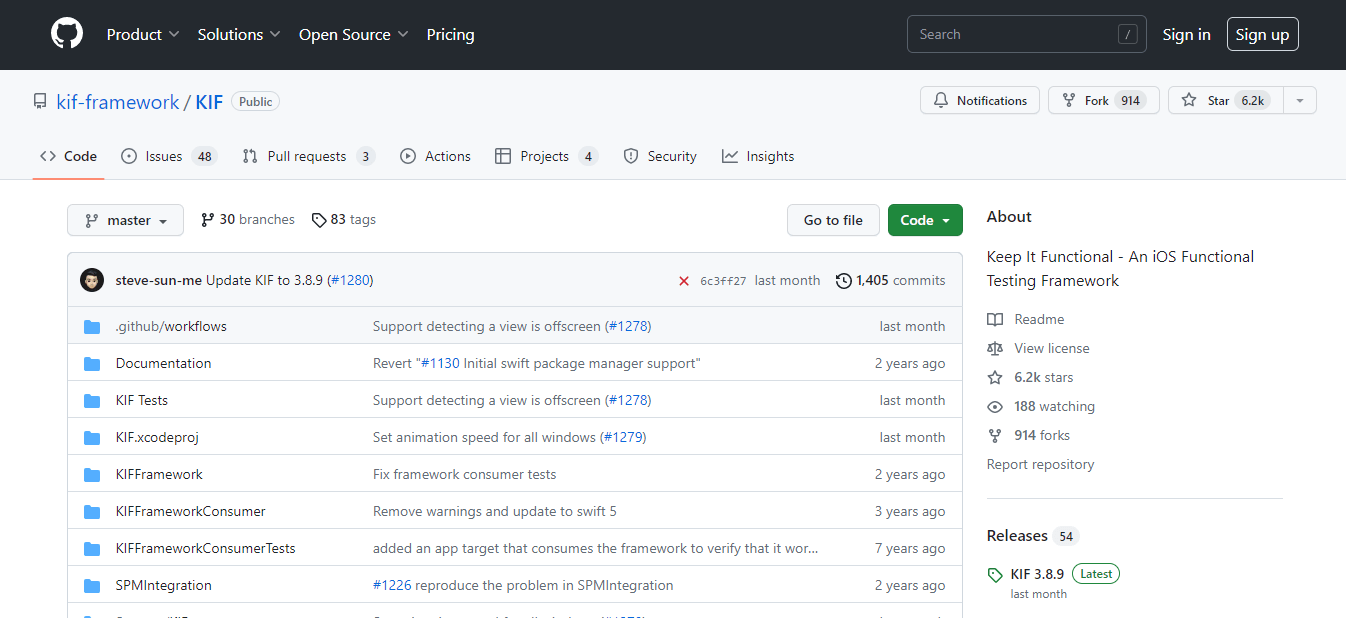
Key features:
- The test for KIF is written in Objective-C, which helps maximum integration with code and lowers the number of layers you have to build.
- It is directly integrated with the Xcode projects. With this iOS testing tool, you don’t have to run additional web servers or get additional packages installed.
- Its test suite runs against iOS 8+ and Xcode 7.
- When you use KIF, it is likely to mimic end-user inputs and actions. This can use tap events wherever possible.
- With KIF, developers can easily run a single KIF test from the Test Navigator, allowing them to test specific features or functionality in their app quickly.
TestFlight
TestFlight is a freely available iOS testing tool provided by Apple. TestFlight helps to distribute the beta version of the iOS apps to the testers and collect feedback. This will improve the iOS app before it is released on the Apple App Store. Currently, it is integrated into the App Store Connect platform. It eases the invitation of users to test iOS apps and gather valuable feedback that allows easy fixation of bugs.
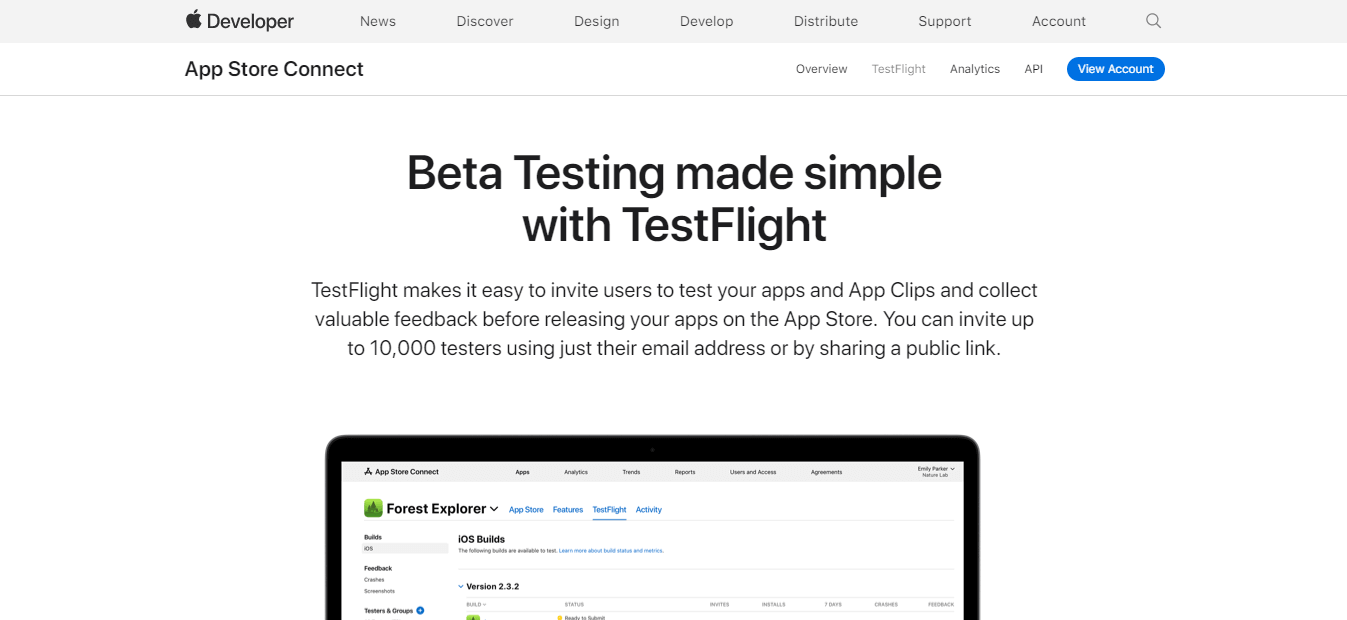
Key features:
- It facilitates beta testing by inviting up to 10,000 external testers to test the iOS apps.
- You can get real-time feedback on the iOS app through TestFlight. Such feedback includes comments, screenshots, and video recordings of the iOS app.
- You get crash reports for the beta version of the iOS apps, which can help you analyze the information to identify and fix bugs.
- Supports apps for various devices, including iOS, iPadOS, macOS, tvOS, watchOS, and iMessage. This help ensures that you test the latest available build.
- You can test up to 100 iOS Apps at a time, either internally or externally, and it allows simultaneous testing of multiple builds.
- You can upload multiple builds of the iOS apps for its testing. This will help you try diverse versions of the iOS apps.
- Once the testing phase is completed, it allows the distribution of the iOS apps to the App Store.
OCMock
OCMock is an iOS testing tool that allows the creation and use of mock objects in Objective-C code for iOS app development. The mock objects are the simulated objects that mimic the real objects’ behavior. It makes the test easy and efficient by allowing you to simulate the complex behavior of real objects in an isolated environment.
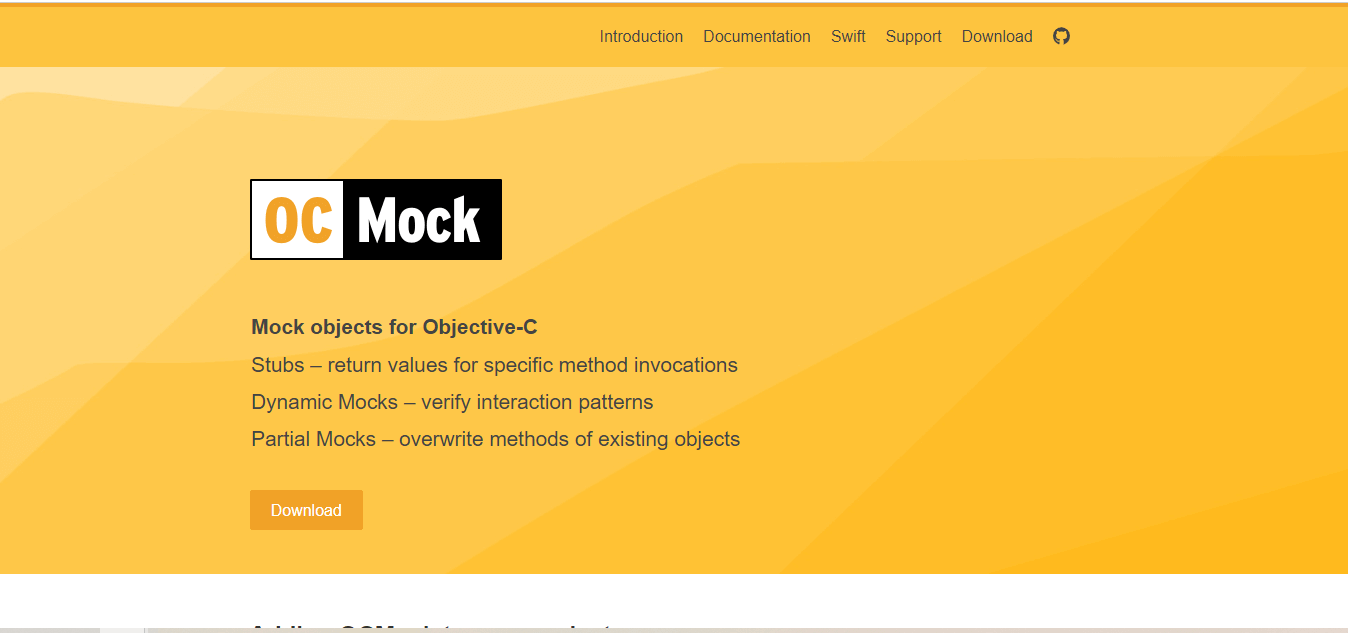
Key features:
- It is an open-source and freely available iOS testing tool. You can contribute to it and make improvements as per need.
- It is compatible with Objective-C, the primary language for iOS app development.
- You can easily add mock objects to the existing unit test while performing iOS app testing. This will save you time and effort in the testing process.
- The use of OCMock is easy due to its simple and intuitive API.
Detox
Detox is an automated end-to-end testing framework for iOS mobile applications and for android apps as well. Detox supports cross-platform testing for iOS and makes it a popular choice for mobile app developers. The only drawback with Detox is that it does not support testing on real devices for the iOS platform. Due to this, you have to rely on the simulators for iOS testing; and this may not accurately replicate real-world device behavior.
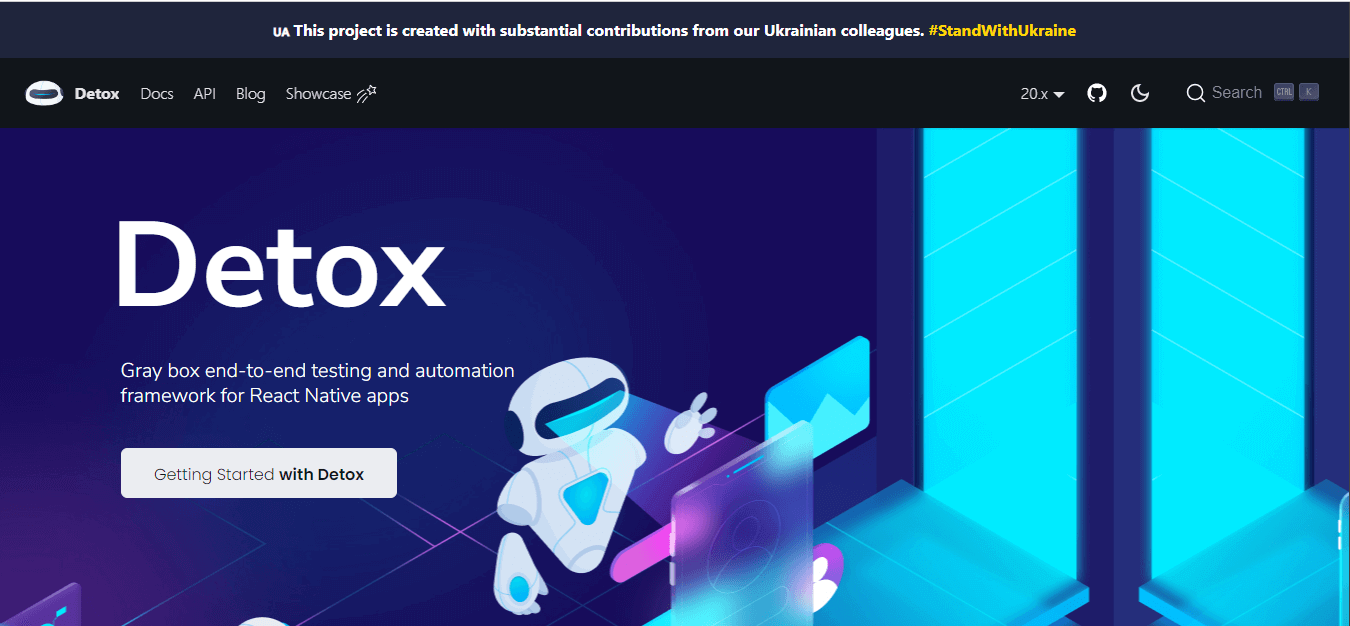
Key features:
- It synchronizes with the iOS app lifecycle and waits for the iOS app to be fully loaded before executing any tests.
- It is compatible with Xcode, Apple’s official iOS app development IDE. You can write, run and debug their test directly from Xcode.
- It utilizes native event simulation to interact with the iOS app. This will help you to simulate user actions like tapping, swiping, and scrolling and thus allows you to test the iOS app user interface and user experience (UI/UX) in a realistic manner.
- Supports multiple iOS versions that help you to ensure that the iOS app works as expected across different versions of iOS.
- It is easy to set up and configure as it has clear documentation and a user-friendly interface.
- You can use Detox with popular JavaScript test runners like Mocha and AVA. This allows you the flexibility to use the tool you are most comfortable with.
Calabash
Calabash is a test automation framework for iOS to perform cross-platform app testing. Calabash provides automation testing for Android and iOS native and hybrid apps.
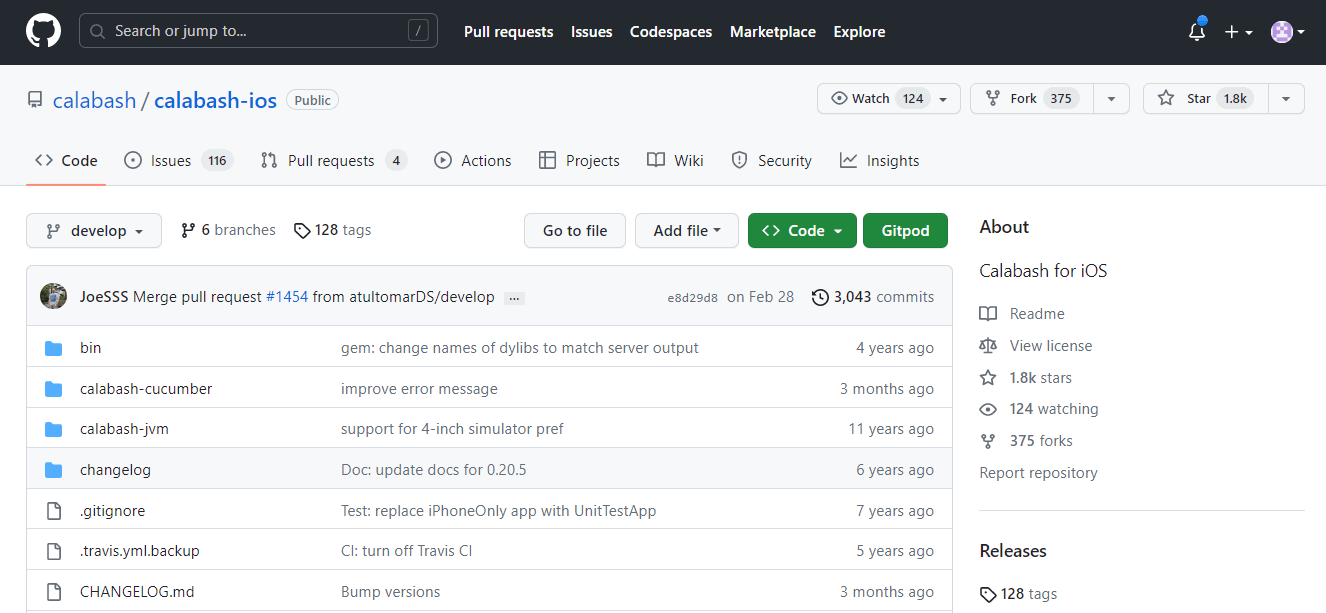
Key features:
- It uses natural language to write tests, allowing you to understand and write tests even if you are unfamiliar with the programming language.
- It has a set of predefined steps which can be used to interact with the iOS app during testing. Examples of such steps include tapping the button, verifying the content of the iOS app, and entering text.
- It uses private APIs to validate the iOS app’s view hierarchy.
- You can test the iOS app on real devices and ensure its correct function on actual devices used by the users.
- It supports testing on simulators and saves the cost of purchasing physical devices.
- It can be integrated with Jenkins and Travis CI. This will help you automate your testing process and execute tests on multiple devices.
Bugfender
Bugfender is a cloud-based iOS testing tool well known for its ability to remote logger, crash reporter, and in-app user feedback. Bugfender ‘s log services collect all events and actions occurring in the application, even though it does not crash, allowing it to reproduce and resolve bugs effectively.
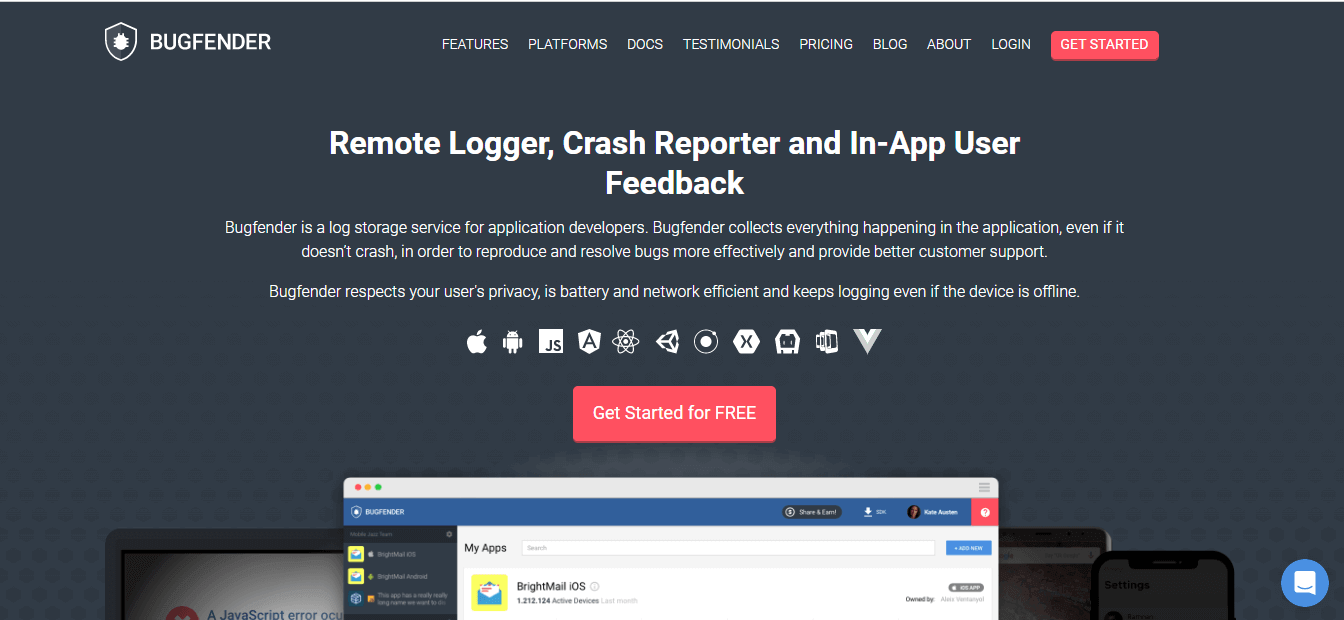
Key features:
- You can collect and evaluate the iOS app logs in real time. It will help you to identify errors and gain insight into how iOS apps are used.
- It gives detailed crash reports on iOS testing, which are used to identify and fix bugs.
- You can remotely debug the iOS apps on the user’s devices with Bugfender.
- You can easily track user behavior and collect data on how the app can be used. It will help you optimize the iOS apps’ performance and gain insight into user behavior.
- It can be integrated with tools like Slack and Jira, which allows to automate workflow and collaboration with the team.
- It uses encryption and security measures to protect the app data collected.
TestGrid
TestGrid is a cloud-based iOS testing tool that helps developers test their iOS apps on real devices and simulators. TestGrid gives a suite of tools that helps manage and organize test runs. It is mainly used to identify bugs and improve the app’s performance, which enhances the overall quality of the iOS apps.
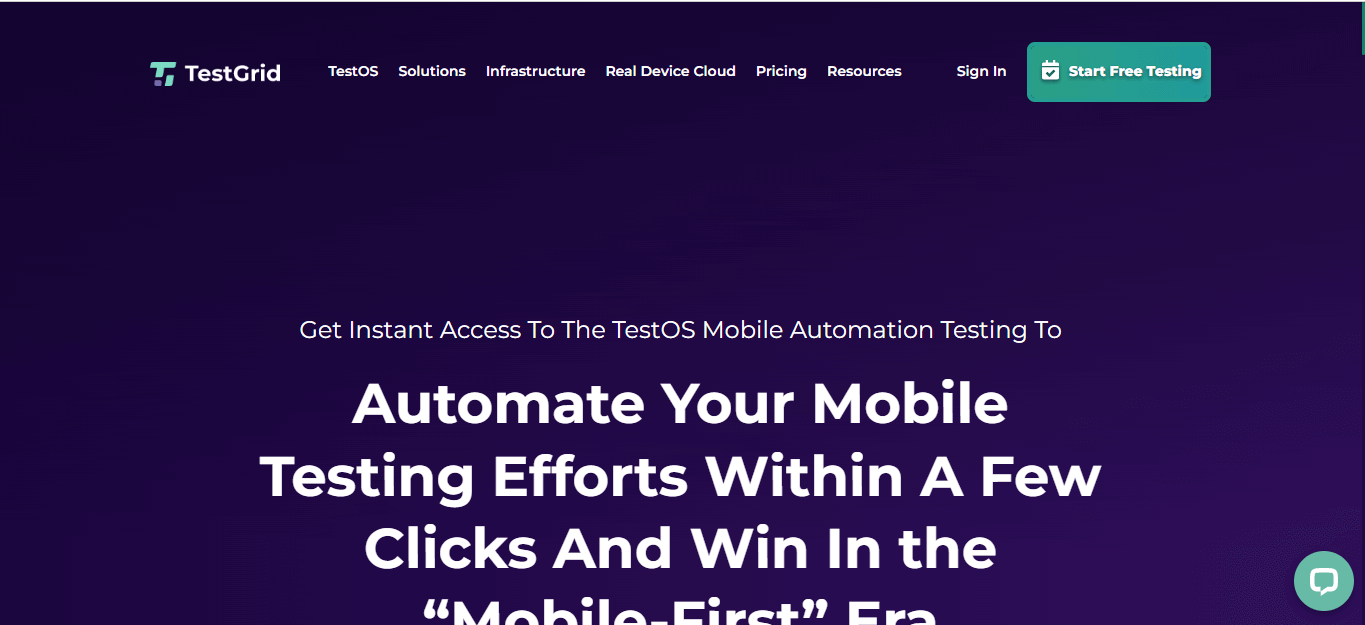
Key features:
- It allows you to test your iOS apps on real devices, which ensures their functionality and work on actual devices used.
- Provides performance profiling and analysis tools to help developers optimize the performance of your iOS app. This involves the identification of slow and inefficient code, the detection of memory leaks, and analyzing CUP and memory usage.
- Using TestGrid, you can test the iOS app’s complex features in just one click.
- This iOS testing tool helps the QA team to reuse the test cases for testing iOS apps and reduce testing times.
- Using TestGrid, you can perform functional, performance, operational, security, and other tests of iOS apps.
- You can run the iOS app test whenever and wherever, as it provides access to a cloud server where you can run 100s of tests.
testRigor
TestRigor is a cloud-based iOS testing tool that provides a powerful solution for iOS app testing. testRigor allows developers and testers to verify the functionality of the iOS apps and ensure it’s working on various Apple devices.
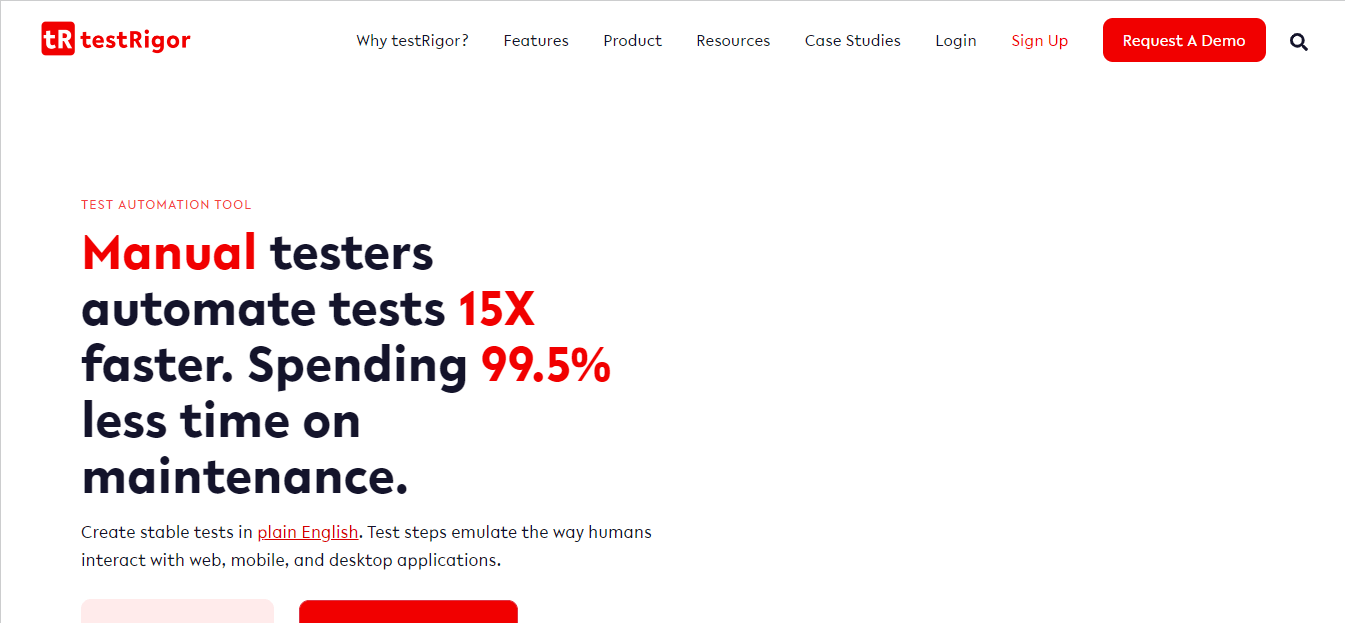
Key features:
- It allows you to write the test cases in plain English, facilitating easy understanding and maintenance of the test by the team involved in iOS app testing.
- This iOS testing tool has a user-friendly interface utilizing the natural language statements, allowing even non-technical members to participate in the testing process.
- Using testRigor, you can test iOS apps that emulate how humans interact with web, mobile, and desktop iOS applications. Examples of those steps include: clicking on buttons, entering text into input fields, and scrolling the page.
- When you use testRigor to test iOS apps, it can represent real-world scenarios and user behavior, improving the quality of the tested software.
- It supports tools like Appium and XCUITest, which allow it to speed up iOS app testing and improve its test coverage.
- You can run parallel iOS app testing on multiple devices, which leads to increased test efficiency.
TestFairy
TestFairy is an iOS testing tool that helps test the tester, automate iOS app distribution, streamline the development process, manage feedback cycles, and facilitate faster release to the App Store. TestFairy provides a range of tools to test, monitor and track the performance of iOS apps.
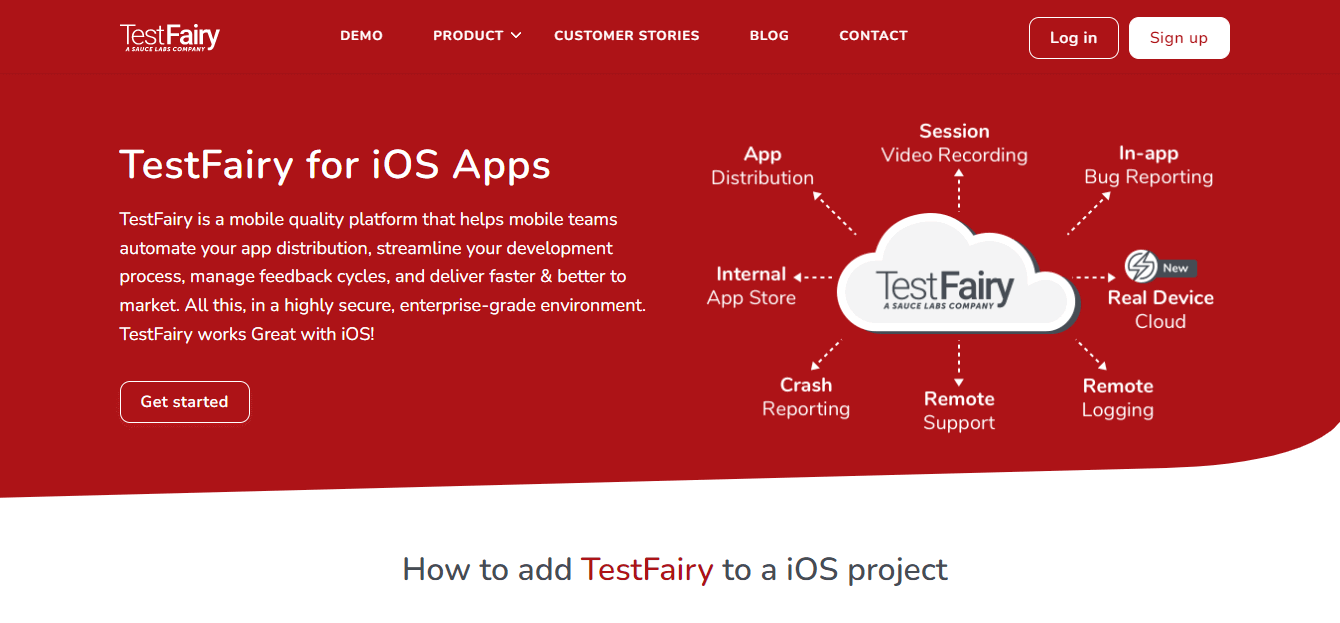
Key features:
- It has bug reporting features that help you to report issues or bugs with the iOS app directly from the app interface. You get detailed bug reports with screenshots, logs, and videos.
- Using TestFairy helps to get direct feedback from the users of the iOS apps related to their functionality, performance, and overall experience.
- Supports Over-The-Air (OTA) Distribution, where testers can install the app directly from their devices without needing an App Store download.
- You can capture the testing process with its ability to video recording that gives you a visual record of the app’s performance and any bugs identified.
- It detects crashes and exceptions in the iOS apps and provides information about the cause of the issues, devices, and OS version.
- It gives developers a range of performance metrics like CPU usage, memory usage, and network activity. With this iOS testing tool, it is easy to identify and optimize the apps for the parts causing any performance issues.
- It is integrated with tools like Jira, Slack, and GitHub, which allows you to streamline your workflow and automate the iOS testing process.
Mobot
Mobot is a robot-powered mobile experience testing solution for iOS apps. Mobot’s mechanical robots help automate the iOS app test, which is impossible for emulators, frameworks, and virtual devices.
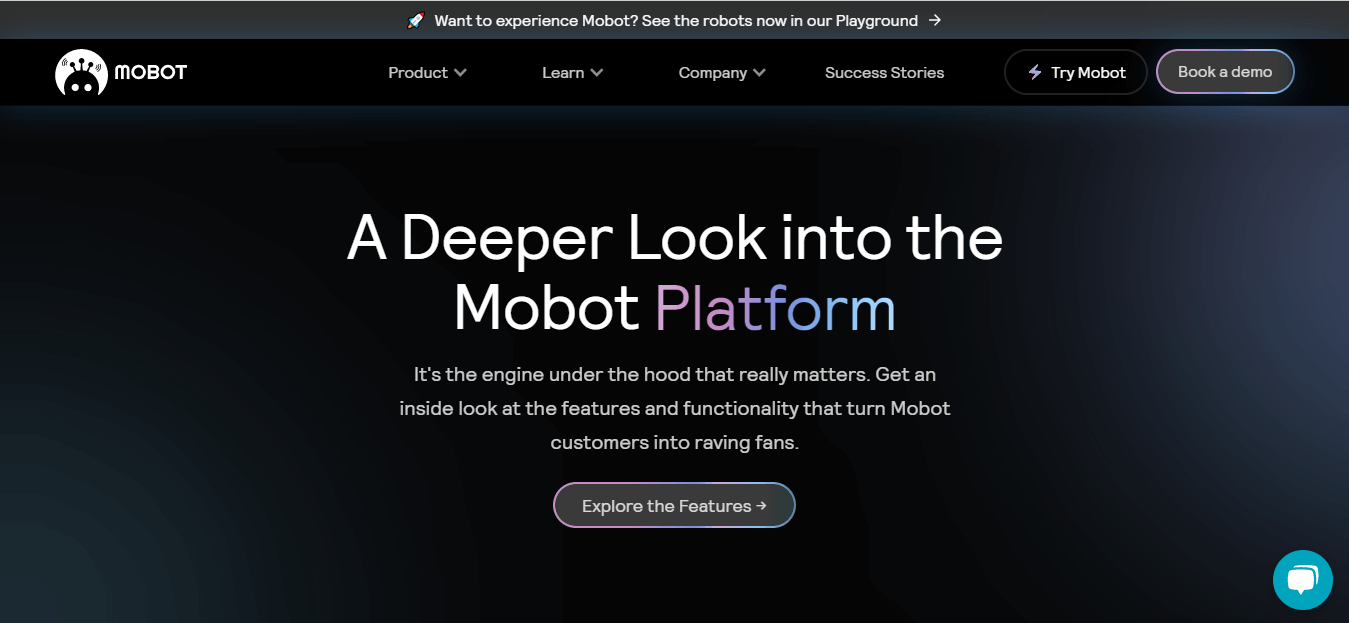
Key features:
- It adds new test cases in a minute to test iOS apps when you require no coding.
- You can upload videos of the test cases and give the option to choose specific iOS devices and OS versions to perform iOS testing.
- Using Mobot, you can capture screenshots of each step while executing the test plan.
- You get test report details defining baseline vs. actual screenshots within the Mobot platform.
- You get human-verified iOS app test results.
- It gives access to real devices to test iOS apps. Its fleet of robots executes test cases like user experience in the real world that mimic real-world user interactions, such as touching, tapping, swiping, and rotating.
- By testing on real devices with real user interactions, Mobot provides a more accurate and reliable testing environment compared to virtual devices or emulators.
- If you want to test iOS apps syncing between an Apple Watch and other Apple devices, Mobot allows developers to test their apps on various devices with different hardware configurations.
Which iOS Testing Tools are your best fit?
To select the best iOS testing tools that fit your testing requirement, don’t just rely on one factor but consider several factors that can affect the quality and smoothness of the iOS testing process. These selection criteria can eventually affect the quality of the iOS apps and allow you to choose the right iOS testing tools.
Let’s take a closer look at each criterion:
- The user interface (UI) is important and should not be ignored. It directly impacts end-users experience with the app, and any issue could lead to the uninstallation of the iOS apps. iOS testing tools that simulate UI help you to identify issues or bugs that impact user experience, allowing developers to make improvements before release.
- Comprehensive testing is vital. An iOS testing tool that provides rigorous testing can detect various issues and ensure the application meets the end user’s expectations. The depth of iOS app testing can also affect risk levels by identifying critical issues before release.
- Usability is essential as it impacts effectiveness and efficiency. User-friendly iOS testing tools can help you to save testing time and effort. This will result in faster and more reliable results. It also facilitates effective team collaboration by making bug tracking and communication easier.
- Integrations play a significant role in determining functionality and compatibility with other iOS testing tools in the testing process. Integrating with other software tools can streamline testing efforts while saving time and effort, improving accuracy and reliability.
- Pricing must be considered when selecting iOS testing tools since it affects budget allocation for app development resources. It is crucial to evaluate long-term costs associated with upgrades, maintenance, support fees, etc., so that the project budget aligns with requirements without compromising on the quality of results obtained from tests done using selected iOS testing tools.
Conclusion
In 2024, technological advancements will continue revolutionizing various sectors, including iOS app development. Testing is a critical step that cannot be overlooked when it comes to ensuring the success of an iOS app. The market is flooded with numerous iOS testing tools, making determining which best suits your software project challenging.
After extensive research and careful consideration, we have compiled a list of the top 24 iOS testing tools for 2024. These framework for iOS come with varying features, capabilities, and pricing options suitable for software projects of all sizes and budgets.
Choosing the right framework for iOS should involve factors such as user interface simulation accuracy, comprehensive testing capabilities, user-friendliness, integrations with other tools, and compliance with the project budget and requirements.
By selecting the appropriate iOS testing tool from our list of top picks for 2024, developers can effectively identify issues or bugs in their apps and fix them accordingly. This will ultimately lead to increased user satisfaction levels and improved overall user experience resulting in a successful iOS app launch. On a side note you can test on iPhone Simulators on 3000+ real browsers hosted on a cloud through LambdaTest.
Frequently Asked Questions (FAQs)
How important is automation in iOS testing?
Automation plays a critical role in iOS testing as it can save time and effort, especially for repetitive or time-consuming tasks.
Is it necessary to use a specialized testing tool for iOS apps?
Depending on the app’s requirements, a specialized iOS testing tool may be necessary to achieve desired results. Different tools specialize in various types of testing, like functional or security.
What should I look for in the pricing of an iOS testing tool?
Pricing is also a crucial concern when choosing an iOS testing tool. Long-term costs like upgrades, maintenance, and support should be factored in when assessing pricing models; ensuring the project budget aligns with requirements while maintaining quality results is key.
How to test iOS applications?
To test iOS applications:
- TestFlight App: Developers use TestFlight to test beta app versions and App Clips. Download it from the App Store for iPhone, iPad, Mac, Apple TV, Watch, and iMessage.
- Vision Pro: TestFlight is pre-installed on Vision Pro.
Employ TestFlight to ensure smooth testing of beta app versions and App Clips on various iOS devices.
How to use ios 16 features?
Discover iOS 16’s features by navigating to Settings > General > Software Update. Explore enhancements in notifications, privacy settings, and productivity tools. Visit Apple’s official site for in-depth tutorials.
What is the best feature in iOS 16?
The standout feature in iOS 16 is subjective, but notable ones include sharing Wi-Fi passwords, haptic keyboard feedback, hybrid dictation, currency conversion via the Camera, live translation, and improved photo privacy with hidden album locks.
What language is used for iOS development?
iOS development primarily employs the Swift programming language. Swift, developed by Apple, is versatile and user-friendly, aiding in crafting apps for iOS, Mac, Apple TV, and Apple Watch. It’s open source, empowering diverse creators to bring innovative ideas to life.
iOS 15 vs. iOS 16: Should You Upgrade?
Comparing iOS 15 to iOS 16, upgrading offers a plethora of new features, a prime incentive for users. However, factors like third-party device restrictions might warrant staying with iOS 15. Users unable to update due to such restrictions should consider remaining on iOS 15.
What is the new features of iOS 16?
iOS 16 introduces a revamped Lock Screen for iPhones, featuring widgets, enhanced customization, new notification location and animation, plus a real-time “Live Activities” system.
What are the key factors to consider when selecting a framework for iOS development?
When choosing a framework for iOS development, key factors to consider include compatibility with the project’s requirements, ease of integration, community support, scalability, and the framework’s capability to handle various testing scenarios efficiently.
Can a single framework cater to various testing needs in iOS app development?
Many robust frameworks in iOS development encompass an extensive array of testing functionalities, catering to varied needs like unit testing, integration testing, UI testing, and more within a unified platform. Nevertheless, the compatibility of these features with the project’s requirements determines their suitability.
Got Questions? Drop them on LambdaTest Community. Visit now







